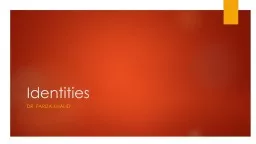

Dr Fariza Khalid Definition what makes you similar to yourself and different from others Deschamp and Devos 1998p 3 who or what someone is the various meanings someone can attach to oneself or the meaning attributed to oneself by others ID: 479674
Download Presentation The PPT/PDF document "Identities" is the property of its rightful owner. Permission is granted to download and print the materials on this web site for personal, non-commercial use only, and to display it on your personal computer provided you do not modify the materials and that you retain all copyright notices contained in the materials. By downloading content from our website, you accept the terms of this agreement.
Slide1
Identities
Dr. Fariza Khalid Slide2
Definition
‘what makes you similar to yourself and different from others’
(
Deschamp
and
Devos
1998,p
. 3).
‘
who or what someone is, the various meanings someone can attach to oneself or the meaning attributed to oneself by others’
(
Beijaard
et al.
1995, p
. 282).Slide3
Definition
Who and what they are, their self-image, the meanings they attach to themselves and their work, and the meanings that are attributed to them by other – are, then associated with both the subject they teach, their relationships with the pupils they teach, their roles and the connections between these and their lives outside school.
(Day, 2004, p
. 53) Slide4
More about identitites
Burk and Stets (2009)Slide5
Person identity refers to the set of meanings defining a person as a unique individual.
Role identity refers to the internalised meaning of a role, or the set of expectations tied to a social position and guiding the attitudes and behaviours that individuals apply to themselves. The role identity of professor, for instance, may include the meanings ‘researcher’ and ‘teacher’ that a person applies to him or herself when playing the role of a professor. Slide6
Social identity is defined as based on a person’s identification with a social group (p.118). Burk and Stets (2009) further explain that although identities differ in their bases, they operate simultaneously in different situations.Slide7
Day et al. (2007
)Slide8
Professional
identity = ‘open to the influence of long-term policy and social trends as to what constitutes a good teacher, classroom practitioner etc.’ (p. 107).
Professional
identity
covers
a teacher’s role, responsibilities, workload, CPD and policy. Slide9
Situated
identity = is located within a specified school, department or classroom and is ‘affected by pupils, support and feedback loops from teacher’s immediate working context which is connected to long-term identity’ (p. 107).
Personal identity = which
is based on life outside of school, and covers teachers’ identities as fathers, mothers, sons and so onSlide10
What literature says about identities?
Identities
are continuously shifting (
Akkerman
and Meijer, 2011
)
Identities are
socially developed, i.e. through relationships and meaning making (Burns and Bell, 2011; Rodgers and Scott, 2008).
There
is a close integration between teachers’ personal and professional identities (
Beijaard
et al., 2004). Slide11
Basic assumptions about identities
Firstly, the formation of identity occurs as a result of the influence of social, cultural, political and historical forces.
Secondly
, identity is developed through relationships with others and involves emotion.
Thirdly
, identity is dynamic and shifting through time, and
Fourthly
, identity involves the ‘construction and reconstruction of meaning through stories over time’
Slide12
Factors affecting identitiesSlide13
Identities in relation to participation in the use of innovations
Khalid (2013)Slide14
Discussions
Why should we study identities?What is possible research about identities (in your areas?)